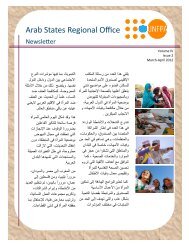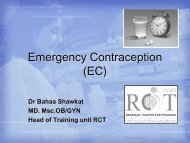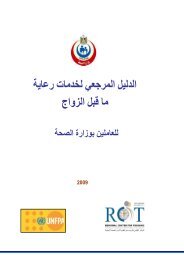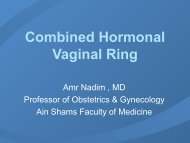ff
STUDY ON REPRODUCTIVE HEALTH IMPACT OF ... - UNFPA, Egypt
STUDY ON REPRODUCTIVE HEALTH IMPACT OF ... - UNFPA, Egypt
- No tags were found...
You also want an ePaper? Increase the reach of your titles
YUMPU automatically turns print PDFs into web optimized ePapers that Google loves.
COMMUNITY LEVEL DEMAND FOR RH-SERVICES 6<br />
The objective of this chapter is to provide quantitative and qualitative information about the<br />
perception of the served communities in the catchment areas of the five FHM facilities towards<br />
RH-services provided in the FHM facilities. The presented in this chapter derived from<br />
information Exit Interview, quantitative data collected during the community- based survey and<br />
included 1500 households in the five communities, and finally FGDs and in-depth interviews<br />
with women, men, girls and male youth in the FHM-facilities’ communities.<br />
6.1 FINDINGS OF THE EXIT INTERVIEW<br />
The total interviewed clients in the studied 25 FHM facilities, in the five HSRP pilot governorates,<br />
were 515 clients (about 20 clients per facility). The clients were purposefully selected to be<br />
females who attended the health units to seek di<strong>ff</strong>erent types of services. The objectives of the exit<br />
interview was to identify the perspectives of the clients towards the received services. The analysis<br />
and presentation of data were designed to measure the perceived impact of FHM on RH-services<br />
in terms of equity, accessibility, acceptability, integration, comprehensive services, continuity of<br />
care and technical quality.<br />
Awareness about the health unit:<br />
Owing to the HSRP strategy of “renovation/reforming of clinics’ operation” of the already present<br />
PHC facilities, people a<strong>ff</strong>irmed that they know the facility and had used its services before it<br />
became a FHM facility.<br />
Table (6.1) shows that 91% of the<br />
clients declared their previous<br />
utilization of the health unit. The<br />
physical existence of the renovated<br />
health unit near home had raised<br />
awareness that there is something new<br />
as expressed by 50% of the<br />
interviewed clients. Propagation of<br />
information among people (relatives,<br />
friends, husbands) ranked the second<br />
source of information about the FHU<br />
(42%). The FHU plays a very minor<br />
role in marketing for its services<br />
(7.7%) either through the home visits<br />
(5.8%) or announcing about its<br />
services (1.6%). The geographic<br />
accessibility of the heath unit has<br />
been asserted, where 81.4% of the<br />
clients stated that they usually come<br />
to the health facility on foot.<br />
Table (6.1) Percent distribution of the interviewed clients<br />
according to previous utilization of the health unit and<br />
geographic accessibility<br />
Accessibility Determinants No %<br />
Previous utilization of the health unit<br />
Yes<br />
No<br />
Total<br />
470<br />
45<br />
515<br />
Sources of knowledge about the FHU<br />
Near house<br />
Neighbors/Friends<br />
Relatives<br />
Personnel from the clinic during home visits<br />
Husband<br />
Announcement from the clinic<br />
Others<br />
Total<br />
Geographic accessibility<br />
Coming on foot<br />
Transportation<br />
91.30<br />
8.70<br />
100.0<br />
Table (6.2) illustrates that the interviewed clients are acquainted with the package of health<br />
services delivered by the FHM units. On the average, each client could mention at least 4 types of<br />
services. The package of reproductive health services ranks the first type of service in the memory<br />
of the clients (75%), with less tendency to mention other services as management of chronic<br />
diseases (10%). Regarding the components of RH services (13 components), 75% of the clients<br />
mentioned immunization, 68% mentioned FP, and 58% mentioned ANC and 45% mentioned sick<br />
baby care. The rare mentioning of services as premarital care, management of RTIs (especially<br />
among males), as well as health services directed to youth, could indicate lacking demand for such<br />
services.<br />
255<br />
106<br />
90<br />
30<br />
21<br />
8<br />
5<br />
515<br />
419<br />
96<br />
49.50<br />
20.60<br />
17.50<br />
5.8<br />
4.10<br />
1.60<br />
0.90<br />
81.40<br />
18.60<br />
Community level demand for RH-services 89










